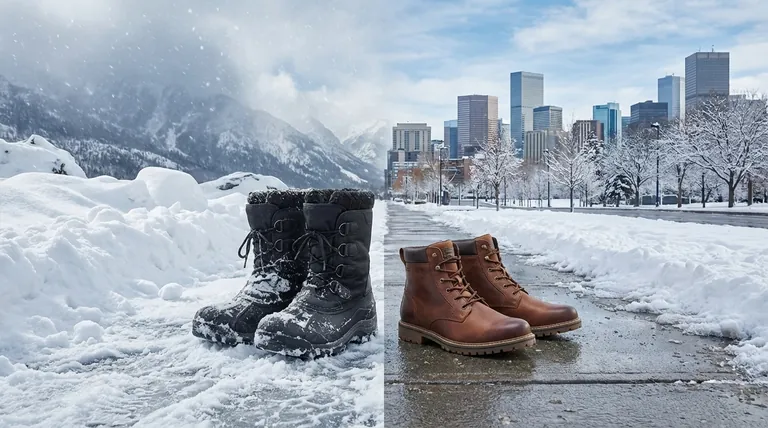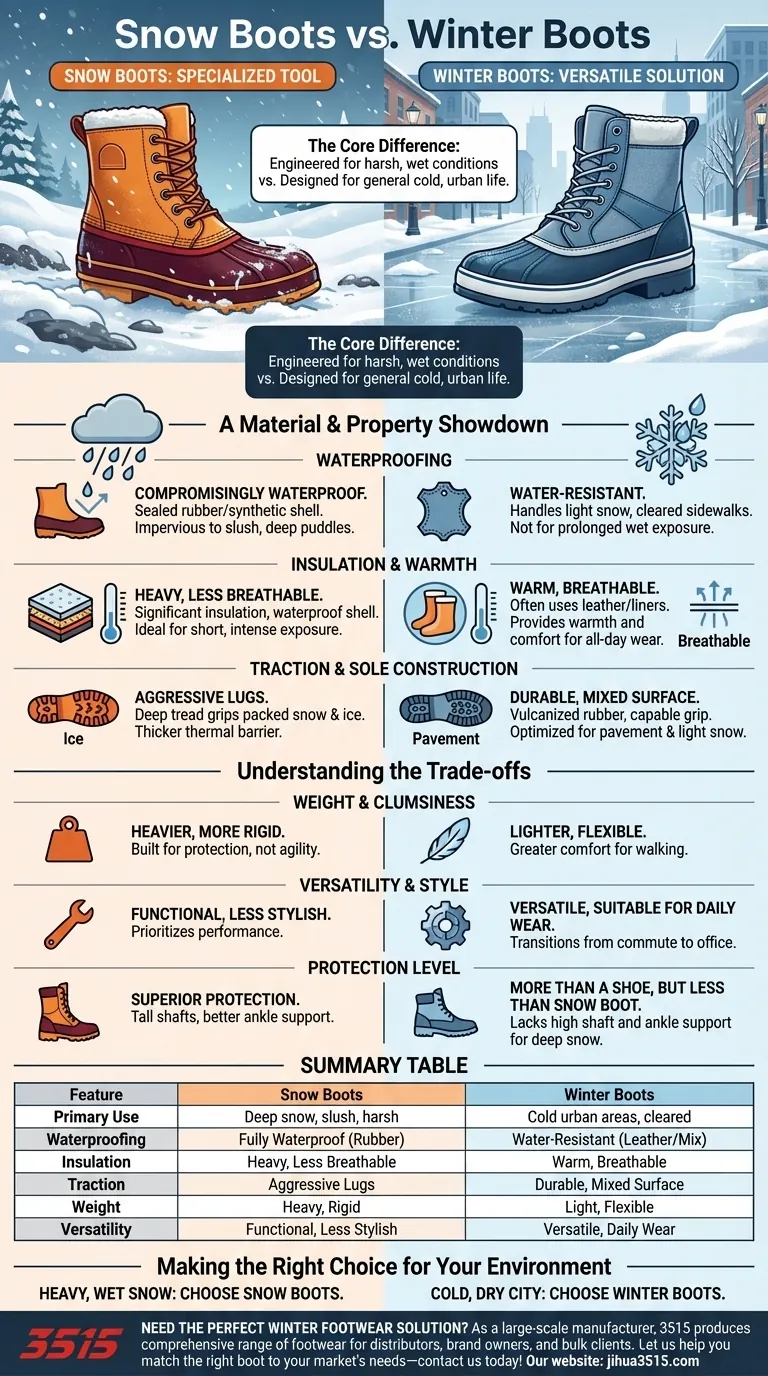The fundamental difference between snow boots and winter boots lies in their intended environment. Snow boots are specialized tools engineered with waterproof materials like rubber and synthetics to conquer deep, wet snow and slush. Winter boots are versatile all-rounders, often using insulated materials like leather, that prioritize warmth and comfort for navigating general cold and cleared urban landscapes.
Choosing between them isn't about which boot is "better," but about correctly matching the boot's core design—extreme moisture protection versus versatile warmth—to the specific challenges of your environment.

The Core Difference: Specialized Tool vs. Versatile Solution
Understanding the design philosophy behind each boot is the key to selecting the right one. One is built for a specific, harsh condition, while the other is made for broad, everyday cold-weather use.
Snow Boots: Your Defense Against Deep Snow and Slush
Snow boots are engineered for a single purpose: to keep your feet completely dry and stable in the most challenging winter conditions. They are the definitive choice for dealing with unplowed paths, deep snow drifts, and icy terrain.
Their construction prioritizes function over all else, featuring high shafts for protection and robust materials that can be easily cleaned.
Winter Boots: The All-Rounder for Cold Urban Life
Winter boots are designed for versatility. They provide the necessary warmth and improved traction needed for moderate cold, maintained roads, and daily errands in an urban or suburban setting.
They successfully blend functionality with aesthetics, making them suitable for a wider range of social occasions where a heavy-duty snow boot would be impractical.
A Material and Property Showdown
While both are built for cold, their material choices and construction create significant differences in performance.
Waterproofing: The Primary Dividing Line
A true snow boot is built to be uncompromisingly waterproof. They often feature a sealed rubber or synthetic lower shell, making them impervious to slush and deep puddles.
A winter boot is typically water-resistant. It can handle light, dry snow and cleared sidewalks, but it is not designed for prolonged exposure to wet conditions or submersion.
Insulation and Warmth
Both boot types are insulated, but their approach differs. Winter boots often use materials like thick, oil-tanned leather or integrated liners that provide excellent warmth while maintaining a degree of breathability for all-day comfort.
Snow boots also provide significant insulation, but their waterproof shells make them far less breathable. This is ideal for short, intense exposure but can lead to sweaty feet if worn for extended periods in milder conditions.
Traction and Sole Construction
The sole of a snow boot features deep, aggressive lugs designed to grip packed snow and ice, preventing falls. The soles are also thicker, creating a better thermal barrier between your foot and the frozen ground.
Winter boots have capable outsoles, often made of vulcanized rubber for durability, that offer much better grip than a standard shoe. However, their tread is less aggressive and optimized for a mix of pavement and light snow.
Understanding the Trade-offs
Choosing the right boot means accepting a set of compromises. Neither option is perfect for every winter scenario.
The Weight and Clumsiness Factor
The robust, protective construction of snow boots makes them significantly heavier and more rigid. They are built for protection, not agility.
Winter boots are lighter and more flexible, offering greater comfort for walking long distances on cleared surfaces.
Versatility and Style
Winter boots are the clear winner in versatility. Their design often allows them to transition from a commute to an office or restaurant without looking out of place.
Snow boots are purely functional. Their design prioritizes performance in harsh weather, often with little to no emphasis on fashion.
Protection Level
Snow boots offer superior protection. Their taller shafts guard against deep snow, and their rigid structure provides better ankle support on uneven, icy ground.
Winter boots offer more protection than a normal shoe but lack the ankle support and high-shaft design needed for trekking through serious winter landscapes.
Making the Right Choice for Your Environment
Your local climate and daily activities should be the final arbiters in your decision.
- If you live with heavy, wet snow and frequent slush: Your non-negotiable choice is a true snow boot for its superior waterproofing and aggressive traction.
- If you navigate a cold, dry city with cleared sidewalks: A winter boot offers the ideal balance of warmth, comfort, and style for daily use.
- If you need a single boot for varied winter activities: Prioritize the winter boot for its versatility, but be mindful of its limitations in extremely wet or deep snow conditions.
Ultimately, the right boot is the one engineered for the winter you actually experience.
Summary Table:
| Feature | Snow Boots | Winter Boots |
|---|---|---|
| Primary Use | Deep snow, slush, harsh conditions | Cold urban areas, cleared paths |
| Waterproofing | Fully waterproof (rubber/synthetic shell) | Water-resistant |
| Insulation | Heavy, less breathable | Warm, breathable (e.g., leather) |
| Traction | Aggressive lugs for snow/ice | Durable soles for mixed surfaces |
| Weight & Flexibility | Heavy, rigid | Light, flexible |
| Versatility & Style | Functional, less stylish | Versatile, suitable for daily wear |
Need the Perfect Winter Footwear Solution?
As a large-scale manufacturer, 3515 produces a comprehensive range of footwear for distributors, brand owners, and bulk clients. Whether you need specialized snow boots with superior waterproofing or versatile winter boots for urban use, our production capabilities cover all types of shoes and boots. Let us help you match the right boot to your market's needs—contact us today to discuss your requirements!
Visual Guide

Related Products
- Customizable Slip-On Safety Shoes Direct from the Factory for Wholesale
- Wholesale Customizable Suede Safety Boots - Puncture-Proof with Velcro Closure
- Durable Leather Work Boots for Wholesale & Custom OEM Manufacturing
- Durable Mid-Cut Tactical Boots for Wholesale & Private Label
- Wholesale Durable Mid-Cut Tactical Boots for Custom & Private Label Brands
People Also Ask
- What are the potential consequences of wearing improperly designed work boots? Avoid Injury & Boost Safety
- What are the cultural perspectives on wearing shoes in the house? A Guide to Home Etiquette & Hygiene
- How does toe box design differ between men's and women's work boots? Fit for a Woman's Foot Anatomy
- How do safety shoes contribute to cost savings for companies? A Strategic Investment in Risk and Cost Management
- What is the purpose of ASTM International? A Guide to Global Quality Standards

















